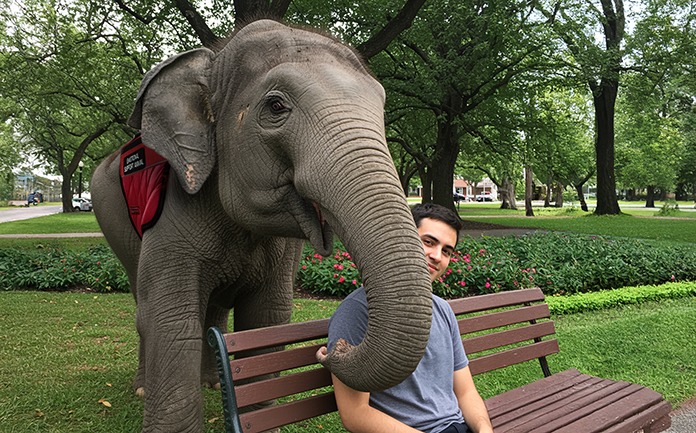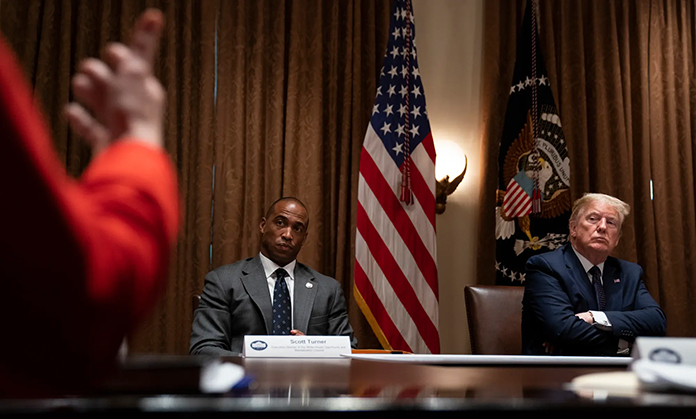“Right now in human beings, avian flu kills 55 percent of the people it infects,” says Laurie Garrett, a senior fellow on global health policy at the Council on Foreign Relations. “That makes it the most lethal flu we know of that has ever been on planet Earth affecting human beings.”
The Council on Foreign Relations devoted a recent issue of the prestigious journal, Foreign Affairs, to what it called the coming global epidemic, a pandemic.
“Each year different flus come, but your immune system says, “Ah, I’ve seen that guy before. No problem. Crank out some antibodies, and I might not feel great for a couple of days, but I’ll recover,'” Garrett says. “Now what’s scaring us is that this constellation of H number 5 and N number 1, to our knowledge, has never in history been in our species. So absolutely nobody watching this has any natural immunity to this form of flu.”
At least 231 people are known to have contracted the virus since 2003, and 134 have died according to the World Health Organization. It has infected birds in about 50 countries and is spreading faster than any other avian influenza ever has. Many experts believe it may pose the worst threat of any influenza pandemic in 30 years.
Indonesia reached an unwelcome record last month, tying Vietnam with 42 confirmed human deaths, the most cases reported anywhere in the world. The latest victim was a 44-year-old man who lived on the outskirts of Jakarta and was reported to have “had contacts with birds.”
The world’s first cluster of human-to-human transmission of bird flu occurred in Indonesia earlier this year. However, the WHO said the strain of virus that caused those seven human deaths was a genetic “dead end” that could not have sparked a pandemic. Concern was further relieved when a new study published in the Journal Proceedings of the National Academy of Sciences came to a similar finding.
Scientists reported that a simulation of one of the two main paths the H5N1 virus could take to adapt to humans — mixing genes with a common human-flu virus — do not create a lethal super bug that could jump from one human to another.
“The manner in which an H5N1 avian virus needs to change in order to be able to spread efficiently among the human population is quite complex and probably takes a number of different changes that we have not yet been able to determine,” said Jacqueline Katz from the Center
for Disease Control.
Health officials fear that H5N1 — which birds have carried from Asia to the Middle East, Europe and Africa — could mutate to a form that easily spreads from human to human. Like most flu viruses, this form started in wild birds — such as geese, ducks and swans — in Asia.
“They die of a pneumonia, just like people,” says William Karesh, the lead veterinarian for the Wildlife Conservation Society. “When you open them up, you do a postmortem exam, their lungs are just full of fluid and full of blood.”
Karesh has been tracking this flu strain for the last several years as it has gained strength, spreading from wild birds to chickens to humans.
The great bird watch
Virginia and other Atlantic seaboard states are implementing wildlife-surveillance plans for the avian influenza, in addition to their public health preparations for any pandemic human flu. The thought is that the virus could come via the Atlantic Flyway which stretches from Greenland to Canada and south through Virginia to Florida and Puerto Rico. American birds summering in Greenland mix with those migrating from Africa and Europe, where avian flu already exists.
The first infected birds could show up along the East Coast this month, experts say.
Virginia is considered a primary sampling state, according to Bob Ellis, assistant director of the wildlife division for the Virginia Department of Game and Inland Fisheries. Ellis led development of Virginia’s plan, which will extend through the fall.
Dozens of species of wild birds, as well as domestic poultry, have been hit by bird flu. So far, officials know of no U.S. bird infected by the H5N1 virus, nor has anyone in the country been sickened by it.
Over the summer Federal officials monitored Alaska and the Pacific Northwest as the likeliest region for the virus’ entry from Asia into the United States. In Alaska alone, the U.S. Geological Survey has 50 camps to take samples from 27 species of shorebirds and waterfowl, said Paul Slota, who oversees laboratory testing of the samples at the National Wildlife Center.
Any results that indicate an avian-flu strain of the H5 or the milder H7 type will be considered a preliminary positive result of avian flu. The H7 strain has cost Virginia’s poultry farmers millions of dollars in recent outbreaks.
Federal officials estimate that they have a 95 percent chance of finding H5N1 even if it is present in as little as 1.5 percent of the sample bird population.
A report by the National Institute of Health (NIH) suggests that California will be the U.S. entry point for the flu. The state is a gateway for travelers from Asia and along with its dense population, epidemiologists predict that within 2 to 4 weeks, the pandemic would spread across the country. Where the pandemic begins is anyone’s guess.
Governmental agencies prepare as never before
Until GlaxoSmithKline’s avian flu vaccine announcement last month, the unique genetic properties and lack of immunity made a horrific doom’s day scenario a very real possibility.
Even still, the success of a vaccine is predicated on availability, distribution and population compliance, so the U.S. may not be out of the woods just yet. Fueled by sobering expert analyses and dismal pandemic scenarios, local, federal and world governments, as well as industry organizations like the National Multi Housing Council, have initiated planning, direction and funding unlike any heretofore.
At the end of last year, Congress appropriated $350 million to upgrade state and local influenza preparedness. The first distribution of $100 million went to the 50 states, the District of Columbia, three local jurisdictions, five U.S. territories and three freely associated states of the Pacific.
This second round will send $225 million, which is meant to help fill identified gaps in flu planning preparedness.
Another round to distribute the remaining $25 million is expected later, said Holly Babin, spokeswoman for the U.S. Department of Health and Human Services.
While the flu vaccine is, at best, months away, there is one medicine to treat it. Called Tamiflu, it is made by the Roche pharmaceutical company in Switzerland. Roche has been selling Tamiflu for years. Only recently, however, did scientists learn of its potential to work against the killer flu, H5N1. That has since created a huge demand and a critical shortage. The Bush administration plans to buy enough
to treat 44 million people.
States can choose to buy additional doses with federal help. The U.S. government is negotiating a price with Roche Laboratories Inc., which makes Tamiflu, and will pay 25 percent of each state’s costs, up to a prescribed amount.
Local government advised to prepare
Governors should make sure they have the legal powers they need to impose quarantines, close schools and keep utilities and transportation running in case of a bird flu pandemic, according to a new primer from the National Governor’s Association.
They should now be working on clear, simple public messages about the risks of bird flu and what preparations are being made, as well as stocking food and medical supplies, the document advises.
“Governors should consider creating a state legal team to review current laws and regulations and assess how they would be applied during a pandemic,” reads the primer, posted on the Internet at www.nga.org.
“For example, decisions on closure of schools, limits on use or practices on mass transit or public transport systems, restrictions on public gatherings, etc., must be determined by state and local officials and supported by local or state policies and law.”
“The effects of pandemic flu will be broad, deep and simultaneous,” Minnesota Gov. Tim Pawlenty said at the National Governor’s Association meeting in Charleston, South Carolina.
“Medical response will be limited, restrained and potentially depleted during a pandemic,” said Pawlenty, a Republican. Outbreaks in people or birds may have to be met with “a pretty aggressive form of containment” and public gatherings eliminated.
Learning from the past
Flu is highly contagious, but the 1918 “Spanish” flu pandemic showed that closing big buildings may help.
“Consequently, public facilities — schools, government offices, transportation hubs, museums, libraries, and convention centers — would be the first considered for closing,” the primer advises.
“Private facilities — shopping malls, concert
halls, skating rinks, gyms, restaurants, bars, theaters, and grocery stores — may be closed under general emergency powers or special powers granted during times of public health emergencies.”
States would also have responsibility for making sure that utilities keep running when workers stay home either because they are sick, caring for relatives, or simply afraid to come out, the governors said.
“What about the guys that go out and repair power lines? You have to think that you are going to have 40 percent absenteeism for a year or more,” said Arizona Gov. Janet Napolitano, incoming chair of the Association and a Democrat.
Governors should be identifying key personnel and making sure each of them has a trained backup in case they cannot come to work, she said.
Telecommunications should be checked now, the document advises. “Many states or state agencies may find, for example, that they do not have sufficient bandwidth or server capacity to allow large-scale telecommuting of its workforce.”
States should “encourage and invest in increased food storage in pantries in government facilities such as schools, prisons, cafeterias, group homes, and state institutions,” the primer says. Businesses and individuals should do the same.
What apartment owners must know
A recent 13-page white paper, “Pandemic Flu: Apartment Owner Preparations” published by the National Multi Housing Council, summarizes its discussion with federal agencies regarding apartment communities and their special risks with regard to a potential outbreak.
The abbreviated version: there are none. There are no special concerns for apartment communities or their operations, than there are for the general population. Common air handling, and other similar systems, are not conduits for spread of the virus and not cause for concern. Nor are there other characteristics inherent to multifamily communities that will especially exacerbate flu transmission rates.
As such, a pandemic flu would level the playing field on city and towns as a whole, and require local response for the most effective and targeted result.
The federal government will rely on local authorities to set the course in answer to individual community needs. Federal officials have urged private sector firms to develop, and routinely review, individualized disaster and business continuity plans.
With that said, the NMHC reports runs a refresher list for apartment owners and the general population. Here’s a summary:
Communication. Good communication is central to the execution of any emergency plan. Lack of knowledge fuels hearsay. Hearsay fuels misinformation. Misinformation fuels panic.
Make a plan for conveying information to employees, residents and those outside the organization should mass, catastrophic illness strike. The U.S. Department of Health and Human Services (HHS) and the World Health Organization (WHO) offers guidance at www.pandemicflu.gov/rcommunication.
Risk management. While simple, these practices offer significant impact in mitigating the spread of a pandemic flu.
– Stop germs from spreading. Wash hands frequently and thoroughly. When washing is not possible, use disposable hand wipes or gel sanitizers.
– Practice good illness etiquette. Properly dispose of used tissues and cough into the crook of your arm instead of using your hand to cover a cough.
– Alter social greetings to minimize handshaking.
– Social distancing. According to public health experts, flu transmission is a function of time and proximity. Flu infection increases as people spend longer periods of time in close contact. Therefore, experts believe that reducing the amount of time people interact can significantly arrest disease transmission. As a result, localities may promote social distancing by closing schools, limiting public gatherings, closing theaters and encouraging individuals to
alter their work schedules or methods.
– Isolate. Encourage sick people to seek medical treatment and stay home when sick. Anyone coming into close contact with sick individuals (i.e., family members, office mates) should also voluntarily isolate themselves.
















